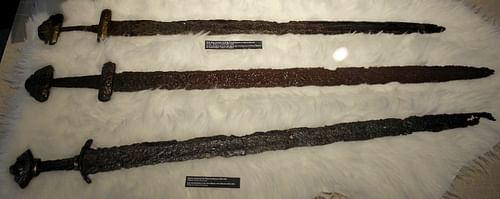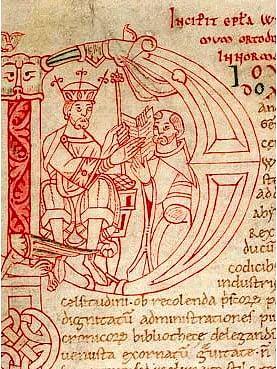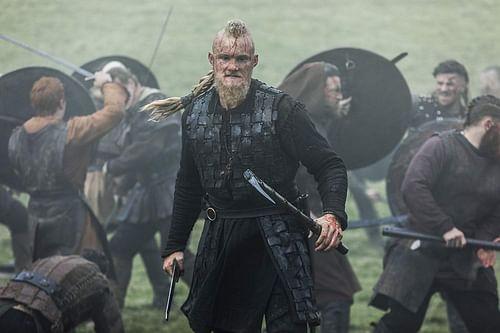Bjorn Ironside (also spelt Björn Ironside; Old Norse Bjǫrn Járnsíða) is a legendary Viking who in the stories surrounding him raids alongside his brothers and his father, the Viking chieftain Ragnar Lothbrok. While the legends mentioning Bjorn are set in the 9th century CE, they are most extensively known from three sources, all from around the 13th century CE: The Saga of Ragnar Lothbrok, The Tale of Ragnar's Sons and Saxo Grammaticus' Gesta Danorum. Here, he is the son of Ragnar and Aslaug (or Thora, in the Gesta), and his most frequently named and most famous brothers are Ivar the Boneless, Hvitserk and Sigurd Snake-in-the-Eye.
On their adventures, it is his crippled brother Ivar who leads the gang, while Bjorn is described as a capable and ferocious warrior who with his prowess can turn the tide of battles. His epithet seems to be quite literal and refers to the strength of his sides, which were like iron (i.e. modern fitness enthusiasts could learn from him). These trips take the brothers from across Scandinavia to Anglo-Saxon England and, in some of the stories, to Normandy, the Frankish Kingdoms, Lombardy and up to a town called Luni or Luna which was supposedly on the way to Rome. Bjorn either becomes the ruler of Sweden (or part of it – Uppsala, central Sweden and all its lands) after his father's death at the hand of King Ælla of Northumbria (r. c. 866 CE) or is gifted lordship over Sweden and even Norway by his father while he still lives. His death or manner of death is not recorded and neither are any possible wives, despite the popular TV series Vikings – in which Bjorn is portrayed by Alexander Ludwig and is the son of Lagertha, not Aslaug – creatively filling in these blanks for us. With regard to children, only the 13th-century CE legendary work Hervarar saga ok Heiðreks mentions any at all: Eirik and Refil. In this story, the former rules Sweden after his father's death and is succeeded by his brother Refil's son, who is also named Eirik.
Although as with the rest of the Lothbrok family the persona Bjorn Ironside may be distantly inspired by one or multiple famous Vikings from the 9th century CE, a clear link is hard to establish; the tradition in which Bjorn occurs is legendary rather than historical in nature, and thus so must be most details of his heroic exploits and life.
Bjorn in The Saga of Ragnar Lothbrok
The best-known and main source for the mythos of Ragnar Lothbrok and his sons is the 13th-century CE Icelandic The Saga of Ragnar Lothbrok (Old Norse: Ragnars saga loðbrókar). The work first describes the childhood of Bjorn's mother, Aslaug, who is the daughter of Sigurd and Brynhild (the legendary dragonslayer and the Valkyrie from Germanic mythology further popularised by Wagner) but loses her parents when she is three years old and grows up with a poor family in Norway, who name her Kráka ('crow') and keep her parentage hidden. Meanwhile, Ragnar, son of King Sigurd Ring of Denmark, rids a town in Götaland from a slight dragon problem and receives the hand of Thora, daughter of the jarl of Götaland, as a reward. With her, Ragnar has two sons, Bjorn's older half-brothers Eirek and Agnar.
Thora unfortunately dies an untimely death. When Ragnar then goes on a raiding trip along the Norwegian coast he ends up looting something unforeseen; he meets Kráka and whisks her off, marrying her for her beauty and quick wits despite her seemingly poor heritage. The couple have four sons together: Ivar the Boneless, Bjorn Ironside, Hvitserk, and Rognvald (and, at a later point, after the episode in Sweden described below, Sigurd Snake-in-the-Eye). The brothers, led by Ivar in terms of strategy and planning and by Bjorn and Hvitserk in terms of battle prowess, often go raiding and adventuring together. According to the Saga, 'They were all great men and the boldest of warriors, and as soon as they were old enough they learned all sorts of skills.' (7, found in Crawford, 98).

On one such raid, to Hvítabø, Rognvald is cut down and dies, but the brothers are victorious nonetheless and pursue the fleeing townsmen. When they turn back to the town, Bjorn speaks a verse:
Our blades bit more than theirs,
our battle-cry was raised—
I must tell this truly—
there on the Gnipafjord.
Let every man who'd like to—
lads, don't spare your swords now—
become, before Hvitabaer [Hvítabø],
the bane of a foeman.
(8, quoted from Waggoner, 14).
Bjorn and his remaining brothers would continue to be the bane of their foemen elsewhere, too. Soon after the Hvítabø episode, they sally forth to Sweden to successfully avenge their half-brothers Eirek and Agnar, who were killed by its king, Eystein. Upon landing in Sweden, Ragnar's sons are described as ruthless and brutal (by today's standards, anyway), burning and pillaging everything and killing everyone who stood in their path. Not even King Eystein's magical cow, Sibilja, who moos so terribly the enemy force starts fighting amongst itself, is a match for them, and after concluding this affair and killing Eystein the brothers go south. The Saga describes how they are headed to Rome but only make it as far as a town called Luni (or Luna) before they hear how much further Rome still is, decide it is all too much of a drag and turn right back around.
Bjorn eventually loses his father when Ragnar has grown just a tad too confident; after boasting he will invade England with just two ships, Ragnar is captured by King Ælla of Northumbria (r. c. 866 CE) and meets his death in a snake-pit. Ragnar's sons then avenge their father by sailing to England and allegedly torturing Ælla by performing the blood-eagle on him (see below).
The Tale of Ragnar's Sons
This latter story, along with most of the main elements of The Saga of Ragnar Lothbrok, is also preserved in the late 13th-early 14th century CE Icelandic work, The Tale of Ragnar's Sons (Ragnarssona þáttr). What the Tale expands on – unsurprisingly, if one has bothered reading its title – is the actions of Bjorn and his brothers, especially after their father dies at the hand of King Ælla. Ivar finds a way to build connections within England from a base in York, and with his new allies he and his brothers defeat the forces of Ælla. Their wrath is not quenched until they torture Ælla to death: 'They now had the eagle cut in Ella's back, then all his ribs severed from the backbone with a sword, in such a way that his lungs were pulled out there.' (3). Luckily for the now ex-king (who has an actual historical counterpart), this method is usually thought to be fictitious and the stuff of these legends, only.
After they have had their fun playing around with Ælla's insides, the sons of Ragnar go raiding far and wide, from England to Normandy, other areas in what is now France, and to Lombardy. As in the Saga, Luni is the farthest point they reach, with Rome here also proving too much of an effort. Their father's heritage is divided, too, and Bjorn Ironside receives Uppsala and central Sweden, and all the lands that belong to it. Along with his more recently born brother, Sigurd Snake-in-the-Eye, and Hvitserk, Bjorn spends ample time raiding widely in France before heading back to his newly acquired kingdom. No more mention is made of him and no tale of his death is recorded, either.

The Gesta Danorum
A third main source connected with the Ragnar legend and in which his son Bjorn Ironside plays a clear part is the Gesta Danorum ('Deeds of the Danes'). Probably written in the early 13th century CE by Saxo Grammaticus, in Latin and not Old Norse like the above two, the Gesta's ninth book contains a trove of information on Ragnar's life and deeds including new characters and events unreported by other sources while still trying to tie in familiar elements. Two otherwise unknown wives of Ragnar's are mentioned here: the shieldmaiden Lagertha and a woman named Swanloga. The resulting mishmash of an account may be due to Saxo having tried to reconcile various stories he had heard or read elsewhere into a single account.
For all its additions, the Gesta also has some clear omissions when it comes to elements usually present in the stories about Ragnar and his sons, one of which would give anyone a mild identity crisis. Aslaug, who is normally depicted as Bjorn's mother, is wholly absent, and thus Bjorn switches mums to Thora (although this is only implied). A whole array of brothers are mentioned, many by different mothers than in the other stories: Sigurd Snake-in-the-Eye (here Siward), Agnar, Ivar, and two wildcards called Radbard and Dunwat are Bjorn's full brothers, while half-brothers include Fridleif (by Lagertha), Ubbe (or Ubba) by an unnamed woman, as well as Rognvald (here Ragnald), Hvitserk and Eirek by Swanloga.
Saxo also explains Bjorn's – in the end very unimaginative – epithet: 'Biorn, having inflicted great slaughter on the foe without hurt to himself, gained from the strength of his sides, which were like iron, a perpetual name (Ironsides).' (9). Bjorn, like the other brothers, assists Ragnar on many trips connected to raiding and ruling across Scandinavia and the British Isles, receiving both lordship over Sweden from him as a reward for his bravery and service as well as Norway as an extra at a later point in time. Just like Ivar, Bjorn behaves in an exemplary way when one of Ragnar's other sons, Ubba, plans to usurp his father and tries to gain Bjorn's support, in a passage which oozes morality:
Esbern [Ubba's grandfather, who was in on the plot] speedily made an attempt on Biorn himself, addressing him most courteously through his envoys. Biorn said that he would never lean more to treachery than to good faith, and judged that it would be a most abominable thing to prefer the favour of an infamous brother to the love of a most righteous father. The envoys themselves he punished with hanging, because they counselled him to so grievous a crime. (9).
The Gesta, too, has the familiar story of Ragnar's boastful but fateful invasion of England where he ends up face-first in King Ælla's snake-pit. Outraged and upset, squeezing a die he was holding when he received tidings of his father's death to such a degree his fingers bled, Bjorn hops aboard the brutal vengeance train along with his brothers. Sigurd and Bjorn take a fleet of 400 ships and declare war on Ælla. Victorious, they capture the unfortunate king, who luckily is unaware of his approaching fate. Rather than sticking to the torture method described in the Tale which was bad enough as it was, Saxo has Ragnar's boys cutting the figure of an eagle in Ælla's back and says that after that 'they salted the mangled flesh.' (9). After this event, Bjorn returns home and no further mention is made of him.
Possible Historical Inspiration for Bjorn
It is clear that the legendary corpus focusing on Ragnar and his sons stems mainly from the 12th and 13th centuries CE and is exactly that – legendary. However, the historical context and the inspiration for the legends are found in the 9th century CE, the pinnacle of Viking raids and expansion, and some of the details are indeed historical. King Ælla, for example, really did rule Northumbria around 866 CE and did see a Viking 'Great Army' land on his doorstep from 865 CE onwards; although his historical death occurred in battle with Viking forces around York c. 867 CE, the legendary torture methods are not mentioned and not likely, either. The struggles of lordship across Scandinavia and the many excursions of both Ragnar and his sons also fit within the 9th-century CE context of the Viking spreading their wings (well, ships) across Europe. The problems with taking possible parallels between the legends and history to a higher level, though, are among others the commonality of Viking names (meaning two Bjorns in two sources do not at all have to be the same person), and the scarcity of sources we have for the 9th century CE.

This is precisely why a straight-up, one-on-one identification of a historical character with the later legendary character of Bjorn Ironside is riddled with problems. However, there seems to be a (side-)current running through some of our modern scholarship that does just that and sees Bjorn Ironside together with another Viking called Hásteinn (also spelt Hastein or Hasting) as the leaders of a historical Viking raid on present-day Spain. Such far-flung expeditions did indeed take place; the earliest one we know of took place in 844 CE and saw Vikings conquer Seville and other places before being chased off by the resident Arabs (the area was then part of the Umayyad Emirate of Córdoba). In 859 CE, a large Viking fleet appears to have cruised out from their base on the Loire river in France and made its way to Spain, too, as well as – according to the tales – North Africa, and areas of Italy and south-eastern France, gathering plenty of booty and slaves in the process. Scholar Elise Roesdahl states that a Viking winter camp is indeed known from the Camargue in the Rhône delta region, and that Pisa and other towns in Italy were plundered, too (200). Moreover, these Mediterranean Viking raids are not just recorded in later Norman and Scandinavian stories but also in such contemporary works as the Frankish Annals of St Bertin and Arab sources.
The Mediterranean raids' alleged connection with Bjorn Ironside and Hásteinn seems to – as far as we know – stem solely from the hand of one William of Jumièges, who wrote his work the Gesta Normannorum Ducum ('Deeds of the Norman Dukes') c. 1070 CE. The legend of Bjorn Ironside, here also the son of a 'King Lothbrok' and described to have attacked the town of Luni, thus existed well before our best-known 13th-century works on him. William's Gesta built upon Dudo of St-Quentin's De Moribus written between 996-1015 CE; 'based on literary rather than annalistic models, Dudo's work has been described as "a deeply unreliable history".' (Hanawault 1994, 111, quoted in Christys 2015). Not a good start, then. Although Hásteinn may have had a historical basis, what we know of the whereabouts of the possible historical Hásteinn does not match up time-wise with William of Jumièges placing him in Spain. Regarding Bjorn, we do not know much more, except that at least two medieval Frankish chronicles mention a Viking they call Berno (possibly Bjorn in Old Norse?) who raided on the Seine in France in the 850s CE. This hardly seems enough to equate either or both of these 9th-century CE Viking leaders with as defined a character as Bjorn Ironside, however. Whoever did lead these expeditions in France and Spain would clearly have appealed to the interest of later writers, though, and the most logical deduction is that one or both of them later helped inspire or became otherwise connected with the legendary figure of Bjorn Ironside, who travels far and wide including to the Mediterranean.
